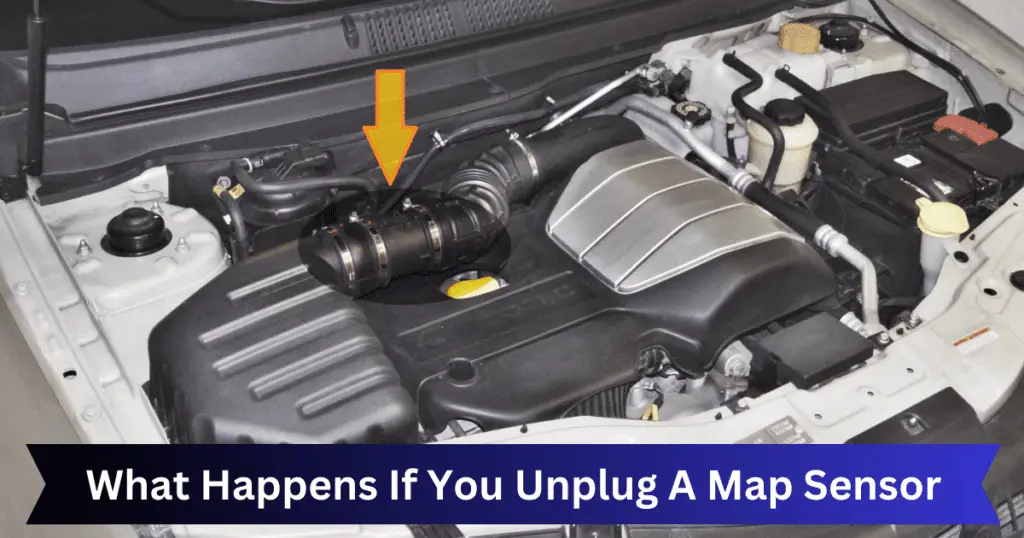That engine management system light striking fear into your dashboard – sometimes it means a temperamental sensor got shaken loose. MAP sensor disconnects create drivability issues but isn’t detrimental if promptly addressed. This guide covers what happens if you unplug a map sensor, MAP sensor functions, unplugging consequences, troubleshooting, replacement, and how to avoid unnecessary check engine triggers down the road.
What Happens If You Unplugged Map Sensor in Fuel Delivery and Ignition Timing

The manifold absolute pressure (MAP) sensor plays a key role in engine management and performance:
- Mounted on the intake manifold, it measures instantaneous air density and pressure inside the manifold upstream of the throttle plate.
- The MAP sensor conveys manifold pressure data to the powertrain control module (PCM).
- The PCM uses that air density reading with other inputs to calculate precisely how much fuel to deliver and when to spark ignition.
- At higher manifold pressure (boosted, lower vacuum), the PCM enriches fuel trim for maximum power. At idle and low loads, it leans out fuel.
So the MAP tells the PCM how hard the engine is working to optimize fuel efficiency and response. Losing that intake air data negatively impacts performance.
What Happens When the MAP Sensor is Unplugged
With the MAP sensor electrically disconnected:
- The PCM detects the loss of critical input and turns on the check engine light with MAP sensor-related trouble codes.
- The engine switches to default pre-programmed fuel and timing mapping based on limited data points. This prevents a complete stall but gives a suboptimal response.
- If the issue poses a safety risk, the PCM enters a self-preservation limp mode limiting power, acceleration, and speed.
- Drivability suffers from an imbalance between air mass and fuel delivery combined with poorly matched ignition timing.
While not an emergency scenario, the PCM using default lookup tables blinds the engine to real-time operating conditions. Let’s explore the symptoms further.
Unplugged MAP Sensor Symptoms
Drivers will notice these MAP sensor disconnect symptoms:
- Lack of throttle response and reduced acceleration
- Rough sporadic idle since base fuel trim doesn’t match the vacuum well
- Diminished fuel mileage as injection quantity is no longer optimized
- Potential misfires and stumbling as timing is off for incoming air mass
- Eventual emission test failures if forced to default long-term fuel trims
What Happens If You Unplug A Map Sensor, prompt reconnection to restore engine performance, efficiency, and clean running.
How to Troubleshoot a Disconnected MAP Sensor
Are you experiencing MAP sensor-related issues? Methodically test:
- Scan for diagnostic trouble codes to confirm MAP circuit faults and check freeze frame data.
- Verify the sensor electrical connector remains fully latched and pins are corrosion-free.
- Back probe the MAP sensor harness and check voltage ranges while manipulating the sensor housing. Look for voltage fluctuations indicating internal sensor problems versus wiring faults.
- With the sensor unplugged, check the reference voltage at the sensor connector. It should read near 5V on that pin. There are no reference voltage points to PCM or harness issues versus the sensor itself.
- Monitor short-term fuel trims with the sensor unplugged then reconnected to see if they correlate properly with manifold pressure changes.
Don’t assume sensor failure without thorough wiring and connector diagnostics. The problem may lie outside the sensor itself.
Potentially Testing Driving Without a MAP Sensor
While not recommended, limited low-load road testing can help confirm MAP-related issues if proceeded with extreme caution:
- Use a scan tool to disable any fuel cutoffs or limp modes that might activate with the unplugged MAP.
- Clear any pending trouble codes before evaluation to gather fresh MAP-specific faults.
- Data log engine parameters like calculated load, oxygen sensor readings, long-term fuel trim, and ignition timing. Compare data with the MAP unplugged versus connected to identify performance impacts.
- Keep road testing very brief, under 5 miles. Drive slowly under low throttle, mid-range RPMs, minimal hills, and no towing.
What Happens If You Unplug A Map Sensor, the engine is essentially flying blind to actual working conditions. Don’t stress it under this handicap.
MAP Sensor Replacement Instructions
If troubleshooting confirms the MAP sensor itself is faulty:
- Remove the electrical connector by squeezing the release tabs and rocking out the male side.
- Extract the single or double fastening screws using the proper size socket. Avoid rounded MAP housing threads.
- Transfer any silencer tube or intake tube alignment brackets to the new MAP sensor if required.
- Snugly hand thread replacement MAP sensor screws before final torquing to spec with a calibrated inch-pound torque wrench. Don’t power tool tighten!
- Clear any residual fault codes and test drive to confirm normal performance is restored. Recheck codes to see if any return indicates further diagnosis is needed.
Installing an exact replacement MAP restores the engine management computer’s environmental awareness.
Preventing MAP Sensor Disconnects and Damage
You can avoid unnecessary MAP sensor issues What Happens If You Unplug A Map Sensor?
through attentive maintenance:
- When working in the engine bay, take care to avoid accidentally knocking the MAP sensor or its connector loose.
- Secure the MAP sensor wiring from vibration damage that can crack solder joints. Zip tie excess length out of the way.
- Keep electrical connectors and the sensor shell dry and free of corrosion and contaminants.
- Don’t ignore check engine lights. Promptly scan and diagnose codes to prevent running defects and relying on default fuel and timing.
Let the MAP sensor do its important job without disruption and your engine will thank you with optimized power and fuel savings.
Maintaining Your Engine’s Environmental Awareness
While home mechanics may tinker with sensors, don’t leave the MAP unplugged as a bad experiment. The engine needs that air data to run strong and efficiently. Watch for check engine alerts, troubleshoot before assuming sensor failure, and follow proper installation procedures. With an operational MAP sensor, your engine can anticipate conditions and deliver the perfect air-fuel mixture for power and economy. failed to find the answer follow read this.
Frequently Asked Questions
What are the symptoms of a bad MAP sensor?
Symptoms of a faulty MAP sensor include lack of power, rough idle, engine misfires, poor fuel efficiency, and the check engine light coming on.
Can a car run without a MAP sensor?
A car can run without a MAP sensor temporarily but will switch to default programming. This causes reduced performance, fuel economy issues, and potentially limp mode activation.
Why did my check engine light come on after unplugging the MAP sensor?
The ECU detects the loss of the critical MAP sensor input and throws a related trouble code, turning on the check engine light.
Will disconnecting the MAP sensor damage the engine?
Temporarily unplugging the MAP sensor generally won’t damage the engine as long as driving remains light. But extended driving missing MAP data risks performance issues and engine wear.
How do I reset my MAP sensor?
Once a faulty MAP sensor is replaced or the connection restored, resetting the code requires disconnecting the battery briefly to clear computer memory and redundancies.





